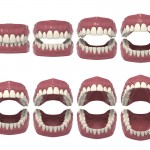
While there is increasing use of implant-retained dentures for those requiring complete dentures the most common treatment for edentulous patients remains the conventional complete denture. Traditional denture fabrication methods involve a number of clinical and laboratory procedures and a number of simplified methods have been explored.
The aim of this review was to evaluate the differences between traditional and simplified methods for the construction of complete dentures
Methods
Searches were conducted in the Medline and Embase databases. Clinical reports , randomised controlled trials (RCTs), controlled clinical trials (CCTs) and reviews about the simplified fabrication of complete dentures published in English were considered. A narrative summary of the findings was presented.
Results
- 11 studies (7 RCTs) were included.
- The studies compared, time and cost, patient satisfaction, clinical effects, masticatory performance, masticatory ability, and professional evaluation.
- No differences were seen between traditional and simplified approaches for patient ratings for general satisfaction, OHIP-edentulous scale, denture quality, or masticatory ability.
- The traditional approach was more expensive and time consuming.
Conclusions
The authors concluded
Current scientific evidence suggests that a simplified fabrication method can replace or partly replace the conventional method to produce dentures. The simplified method is cheaper and more efficient and guarantees quality. The use rate of the simplified method can be increased, based on current evidence; however, specific rules should be devised to restrict the simplified construction, and detailed research should be conducted to further investigate specialized cases, such as displaceable upper ridges, or patients with mobile fibrous or knife-edge lower ridges.
Comments
We considered an earlier review of simplified verses traditional approached to complete denture construction by Paulino et al in 2014 (Dental Elf -23rd Oct 2014). The earlier review included 3 studies reported in 6 papers. This review also includes a couple of studies that report different study outcomes in separate article. Consequently the number of studies to assess whether simplified approaches are as effective as traditional methods is limited. While two databases have been searched it is not clear whether independent and duplicate data abstraction and study quality assessment was carried out.
There is variation in the simplified approaches used and the authors suggest that clarifications of the stages of simplified construction techniques is required. As all the studies were conducted by experienced prosthodontists more work needs to be carried out to see if similar results can be obtained by less experienced practitioners.
Links
Primary paper
Ye Y, Sun J. Simplified Complete Denture: A Systematic Review of the Literature. J Prosthodont. 2016 Feb 24. doi: 10.1111/jopr.12463. [Epub ahead of print] Review. PubMed PMID: 26916810.
Other references

Simplified complete denture fabrication can replace traditional approaches suggests review https://t.co/EAL2r2qEMW
Review suggests that simplified denture fabrication can replace traditional approaches https://t.co/EAL2r2qEMW
Can simplified denture fabrication can replace traditional approaches? https://t.co/EAL2r2qEMW
Simplifying traditional approaches to complete denture fabrication works suggests review https://t.co/EAL2r2qEMW
Don’t miss- Simplified complete denture fabrication can replace traditional approaches suggests review https://t.co/EAL2r2qEMW